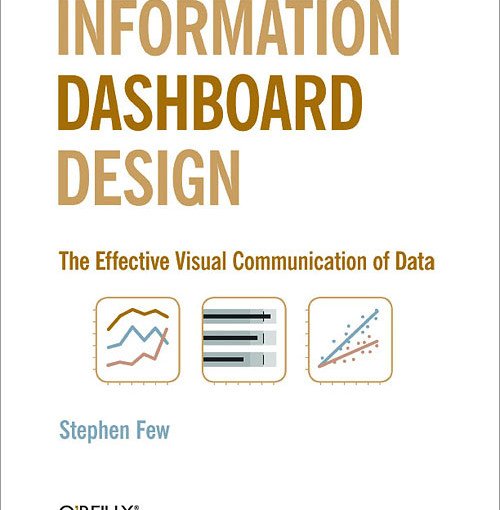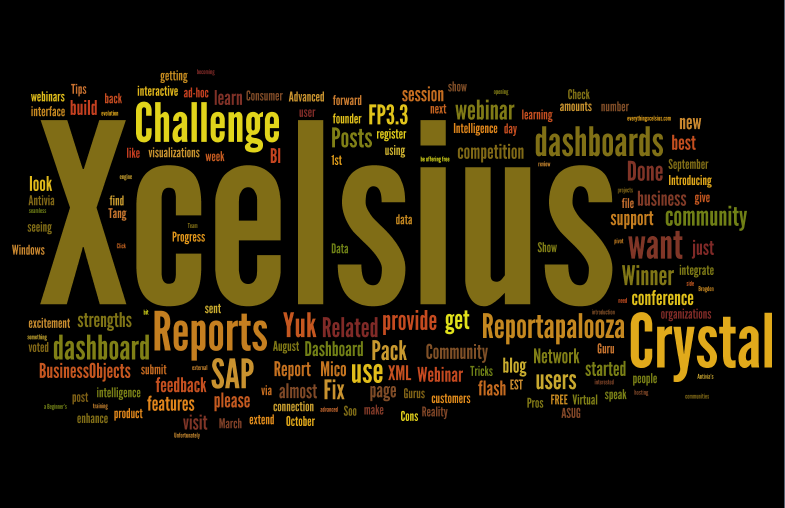On Tuesday, April 17, 2012, the space shuttle Discovery made its historic final flight. Seeing images of Discovery flying over the US capitol piggybacked to its specially modified Boeing 747 gave me (and I’m sure many others) a profound admiration for NASA and its shuttle program. But it also left me wondering about the American space program’s future, worrying if its glory days are behind rather than ahead.

On the same day, with unintentional irony, SAP posted an article on SCN about its long-anticipated statement of direction (SOD) for dashboards. The SOD served as a lead-in to yesterday’s popular ALL ACCESS to SAP BusinessObjects Dashboards (Xcelsius) webinar (see Pieter Hendrikx‘s live blog of the webinar). SAP speakers Mani Gill, Ty Miller, Jason Rose, Ian Mayor, Scott Leaver, and Mani Srinivasan were joined by Xcelsius Guru Mico Yuk for a brief presentation followed by a live Q&A session. The prepared content mostly recapped what was introduced in the SOD document, leaving most of the session for Q&A. Most of the conversation centered around three topics:
- What is going to happen to Xcelsius/Dashboards
- What is going to happen to SAP BEx Web Application Designer?
- What is Zen and wasn’t it called SAP BusinessObjects Analysis, edition for Application Design last year?
Two Types of Users
First, conversations about Xcelsius/Dashboards and SAP BEx Web Application Designer are primarily held by one group of people: developers. In the SOD, SAP describes two broad categories of data visualization: professionally authored and self-service. These two broad categories have long existed in BI. We often use them to compare and contrast Crystal Reports with Web Intelligence (although enterprise reporting vs. ad-hoc query and analysis is another method of comparison).
SAP BusinessObjects Dashboards and Zen [UPDATE: which shipped as SAP BusinessObjects Design Studio] are focused on the needs of “power users and IT”, which was probably the majority of attendees on the webcast. Zen is intended to be “a new, unified technology stack” that will begin life primarily intended as the successor to SAP BEx Web Application Designer (focused on SAP data sources like BW and HANA) and evolving into a successor for Xcelsius/Dashboards (focused on a broader set of data sources) as well.
But what about self-service dashboards? “In the future, exploration views (a functionality of SAP BusinessObjects Explorer) [introduced with SAP BusinessObjects Business Intelligence 4.0 Feature Pack 3] will become the preferred technology for building self-service BI applications.” And although Web Intelligence is not mentioned, its evolution in BI 4.0 continues to blur the line between “query and analysis” and “dashboard”. And from an end-user perspective, SAP will eventually deliver Exploration Views and Web Intelligence in a single mobile app, rather than the two apps that are required today.
Although a frequent criticism of SAP is that there are “too many BI tools”, I am glad to see SAP continue to recognize that these two broad categories of users require different tools.
The Waiting Is the Hardest Part
Second, Tom Petty, a well-known business intelligence industry analyst, had the following to say about SAP’s Dashboard Statement of Direction:
The waiting is the hardest part
Every day you see one more card
You take it on faith, you take it to the heart
The waiting is the hardest part
SAP’s Statement of Direction outlines three phases. We’ll see the fruits of phase one go into ramp-up in late 2012, but the latter phases will take us into 2013 and probably 2014. That’s a long time to wait. Users of SAP BEX Web Application Designer will be able to use the inaugural edition of Zen. But for the foreseeable future, existing Xcelsius/Dashboard Design customers can continue using the product, extend it with some useful partner solutions, and hope for a fairly routine migration path (see related article, Between an Xcelsius Rock and Dashboard Design Hard Place).
The SOD is developed from the traditional “enterprise software company” cookbook, with emphasis on “protecting existing investments” and merging tools from different lineages into a unified whole. This is what “good” enterprise software companies do. But these typical assumptions mean that we must wait patiently for the results. I can’t help but wonder (aloud on the latest Diversified Semantic Layer podcast, State of the Dashboard Take 2) if a better strategy would be assembling a team of genius developers and building something completely new, without the baggage of existing products. Customers would get a groundbreaking mobile-first tool faster and be less likely to hear the siren song of other vendors like Tableau, Tibco, and QlikTech, and the like.
I recognize that I don’t know how to run a large enterprise software company and don’t understand their traditions. But neither do the young minds creating new data visualization start-up companies. AOL or Yahoo could have built Facebook but didn’t. Kodak or Polaroid could have built Instagram but didn’t. HP or Dell could have built the Apple iPad but didn’t. History is replete with tales of innovation and disintermediation- of David outsmarting Goliath. (See New York Times columnist Nick Bilton’s article, Disruptions: Innovation Isn’t Easy, Especially Midstream)
But perhaps SAP intends to surprise us with the efforts of a secret development team toiling away in an unlikely location like Hilo, Hawaii? [UPDATE: Hilo was the code name for SAP Visual Intelligence, later renamed SAP Lumira]
Xcelsius really is the new Desktop Intelligence
Lastly, this week’s events cemented for me (but not for the SAP panelists) that Xcelsius really is the new Desktop Intelligence (see related article Thoughts on Xcelsius). Yes, I’m fully aware that this analogy is short-hand for all kinds of negative imagery. But there is positive imagery that is worth remembering. Let’s not forget that with Desktop Intelligence, both Business Objects (the company) and SAP that purchased it, the vendor was committed to protecting existing investments and providing a migration path via tools like the Report Conversion Tool. Customers were grateful for the amount of time that Desktop Intelligence continued to be supported. But I’m sure that many at SAP wished they could have stopped support sooner. One reason for the long retirement period was it took Web Intelligence, the successor, many years to reach an adequate level of functionality to replace its predecessor. The reason Desktop Intelligence had a retirement in the first place wasn’t because the tool lost its usefulness. SAP could certainly modernize it if they wanted to (see my almost-plausible April 1 Hell Freezes Over article). Desktop Intelligence was retired because a majority of its users lost interest in desktop applications in favor of web applications. Now those same customers are shifting attention from the web to the mobile device. So we shouldn’t blame the vendor when we, the customers, are making their products obsolete.
Like Desktop Intelligence before it, some customers will continue to use Xcelsius and Dashboard Design well beyond the official end of support. But as a career professional, I’m labeling it as “the new Desktop Intelligence” as a reminder that I need to prioritize learning new skills.
Conclusion
SAP did a good job in authoring the SOD and responding to live Q&A. The effort was necessary and time well spent. And after the webcast I’m looking forward to SAPPHIRE even more. But even with all of the clear answers, I’m unsure. Unsettled. Perhaps it’s because Xcelsius can’t figure out what it wants to be when it grows up. Or maybe it’s because I’m the one who can’t figure out what I want to be when I grow up.
Business Intelligence is supposed to be about fact-based decision making. But today, it’s about emotion as well.
What’s your reaction to the SAP BusinessObjects Dashboarding Strategy and Statement of Direction and the ALL ACCESS SAP webinar?
Additional Resources
- The Future of Dashboards – Strategy and Direction by Adam Binnie on SCN (released April 17, 2012)
- SAP® BusinessObjects™ Dashboarding Strategy and Statement of Direction (released April 17, 2012)
- Slide deck from All Access SAP webinar, Dashboarding Statement of Direction (added April 21, 2012)
- Pieter Hendrikx‘s live blog of the All Access SAP webinar
- The Diversified Semantic Layer podcast, State of the Dashboard – Take Two (recorded April 18, 2012)
- Xcelsius, Zen and Nirvana by Donald MacCormick (written April 19, 2012)
- Is Patience Still a Virtue? by Jamie Oswald (written April 19, 2012)
- ASUG News editor Thomas Wailgum reports on SAP BusinessObjects Dashboards Roadmap: Unveiled and Inspected (written April 19, 2012)
- Disruptions: Innovation Isn’t Easy, Especially Midstream by Nick Bilton (written April 15, 2012)
- Farewell, the New Frontier editorial by Charles Krauthammer regarding the space shuttle Discovery (added 04/23/2012)
- For Many of You, Zen is Indeed New Information, by Scott Wallask, Managing Editor, BI Expert Online (added 04/26/2012)
- Executing on the Statement of Direction for Dashboarding by Anita Gibbings (added December 19, 2013)
Follow on Twitter
- Connect with Anita Gibbings, Mani Gill, Scott Leaver, Ian Mayor, Jason Rose, and Mico Yuk on LinkedIn
- Follow topics Xcelsius Statement of Direction and All Access SAP on Twitter (hashtags #XcelsiusSOD and #AllAccessSAP)



Three things:
ONE:
—–
Yes, I am afraid that Xcelsius will be the new Deski.
TWO:
—–
Those categories of “Enterprise reporting” (=CR?) and “ad-hoc reporting” (=Webi?) are just standard sales pitch trying – in vain – to give reason for two separate reporting tools. Why, in the 21st century can one reporting tool not be ad-hoc (=easy to use, intuitive GUI) and be enterprise ready and pixel-perfect I ask? I already explained, why SAP (as well as BusinessObjects) has so so many reporting tools, only caused by acquisitions and overlapping products and no consolidation.
THREE:
—–
Self-Servicing? Well, SALES might make you believe XC is self-servicing, but building a visually sound, information rich, visually well designed dashboard is NEVER something you can do on the fly. Controllers are absolutely over their heads with such a task.
Next thing is, customers want to design their own cars from the ground up. What fun that would be.
Andreas, thanks for sharing your thoughts. Always love getting comments and hearing different perspectives. I’ll probably tackle “too many tools” in a future post.
Dallas, Andreas. Thanks for sharing your thoughts on this really hot BI topic.
Also would like to thanks DSLayered for posting the Dashboard Take 2 audio (http://t.co/JTadZFND).
My reaction to the SAP BusinessObjects Dashboarding SOD and ALL ACCESS Webinar is why took so long to communicate things that were already out there.
HTML5 for Xcelsius – known since early January.
ZEN, nothing but SAP Analysis for App Design (Analysis Studio) – known since March.2011
and SAP Exploration Views as a Self Service Dashboarding – they wish. Well may be if what you are looking for is to replace PowerPoint slides with a short-capabilities, single source, on top of a complicated stack tool.
Unfortunately SAP keeps letting me down. I don’t think they react quickly enough to mobile needs. They have too many balls in the air but haven’t come up with the silver bullet yet.
ZEN could be that silver bullet, however in order to achieve that it will have to be as simple to use as Xcelsius or even simpler, which I doubt. ZEN should be open to source data for any of the connections available in BI40 (not only BW or HANA). It should include the feature that has made xcelsius so popular: excel logic power. Of course, security, hierarchies, etc; and, finally but not least easy to publish and maintain mobile apps/dashboard.
Still don’t understand why it took so long for SAP to realize that regardless the so many tools they got from BOBJ acquisition they didn’t get the silver bullet one but the pieces and resources to build one.
In the meanwhile, if you are going to pursuit mobile (IOS) dashboard in the next calendar year (2012 – mid 2013) you are going to have to go with a solution which is not entirely SAP.
I am concerned,
SAP now seems to position THREE tools for dashboarding: Xcelsius (for non SAP BW customers), then SAPZEN in the near future (for SAP BW only customers and people who enjoy coding, which is NOT me unless coding can be done Bret Victor’s way, see here:
, and SAP BusObjects Explorer for some. The outlook that Xcelsius and SAPZEN will merge in the future is nice, but when I look at the DESKI to WEBI conversion as a prelude so to speak I am not so positive.
This fragementation is just an invitation for any competitor of SAP to show customers how it can be done using ONE tool only, I am afraid.
The other thing SAP is still not adressing ( the big competitors are not doing any better I believe): Effective Visual Design or the art of DataVisualization. This discipline seems to be totally neglected in favor of glitzy, but data & information sparse dashboards.
Andreas,
You are correct. But even before shipping Zen, SAP has three shipping dashboard tools today: Xcelsius/Dashboard Design, BEx Web Application Designer, and Explorer. So the only difference is SAP is proposing to harmonize the first two to utilize common components, if not an outright integration of the two tools into one.
Dallas
I think SAP actually has 3 and 1/2 dashboard tools. Webi in BO4.0 would be the 1/2. Altough it isn’t as robust as the others, between the Input Controls and Linking of objects in a document, you could create a useful but limited “Dashboard”.
Just my opinion.
Mickey
I agree about Webi, esp. as its mobile capabilities grow.